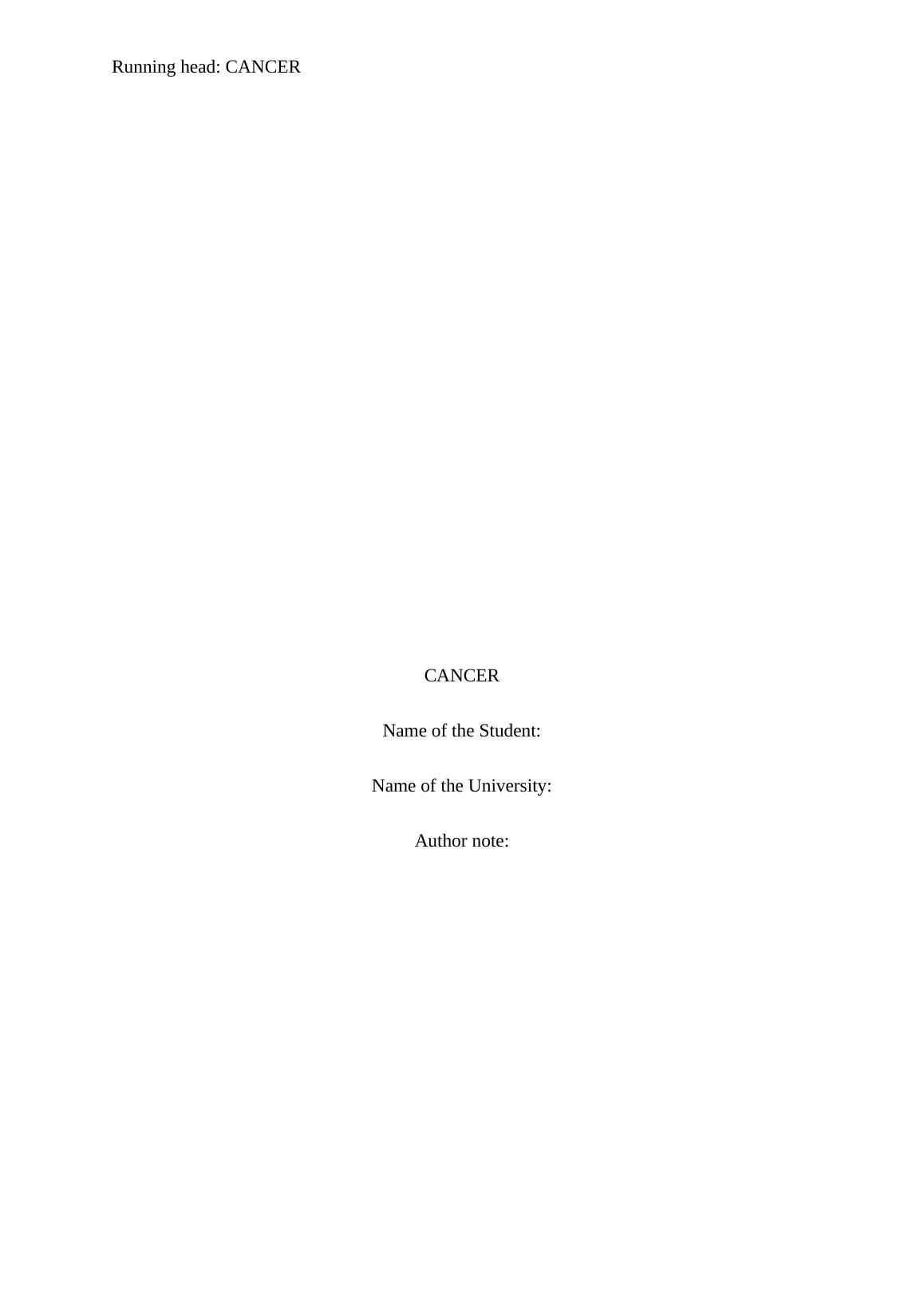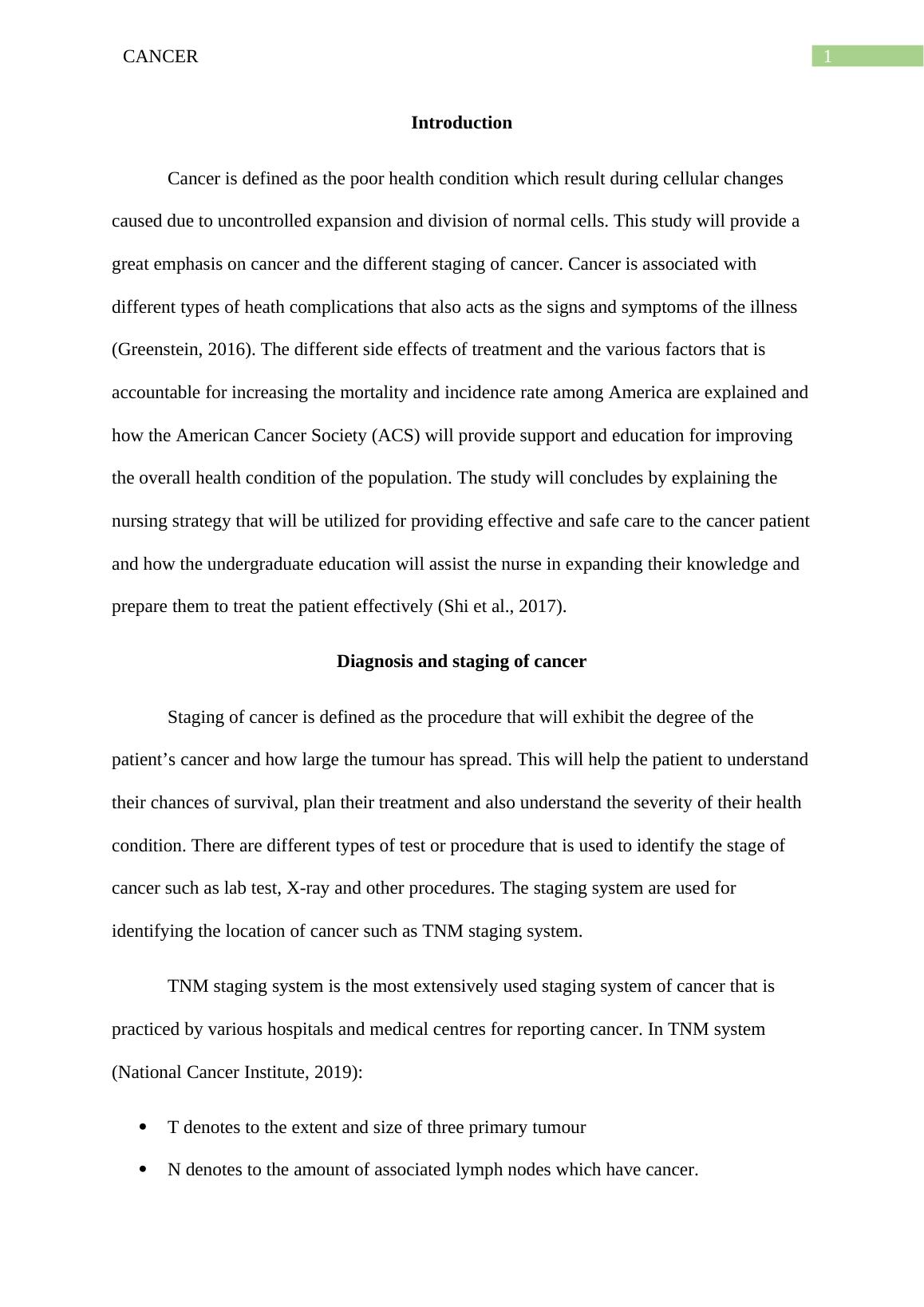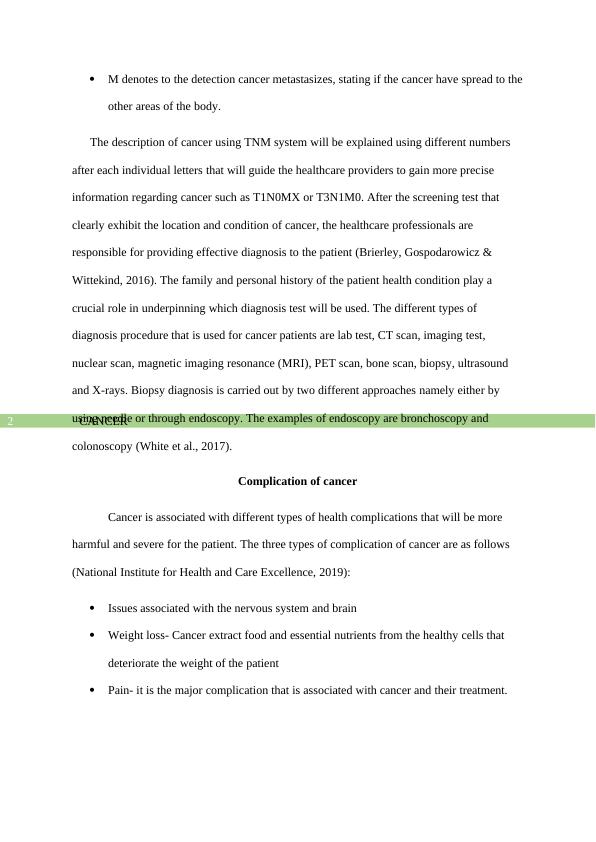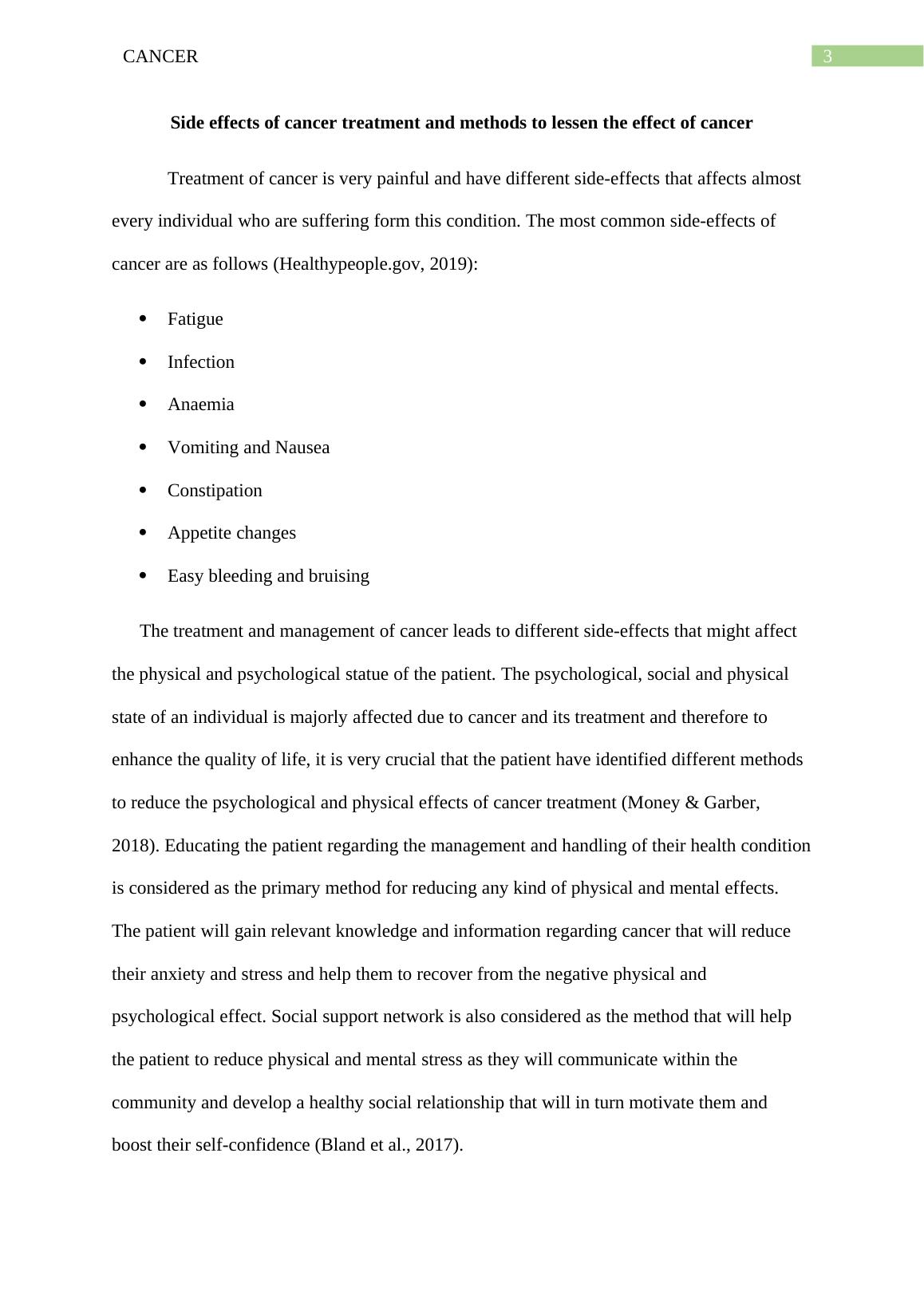Cancer: Diagnosis, Staging, Complications, Treatment and Nursing Process
Added on 2022-10-10
12 Pages2737 Words302 Views
Running head: CANCER
CANCER
Name of the Student:
Name of the University:
Author note:
CANCER
Name of the Student:
Name of the University:
Author note:

CANCER1
Introduction
Cancer is defined as the poor health condition which result during cellular changes
caused due to uncontrolled expansion and division of normal cells. This study will provide a
great emphasis on cancer and the different staging of cancer. Cancer is associated with
different types of heath complications that also acts as the signs and symptoms of the illness
(Greenstein, 2016). The different side effects of treatment and the various factors that is
accountable for increasing the mortality and incidence rate among America are explained and
how the American Cancer Society (ACS) will provide support and education for improving
the overall health condition of the population. The study will concludes by explaining the
nursing strategy that will be utilized for providing effective and safe care to the cancer patient
and how the undergraduate education will assist the nurse in expanding their knowledge and
prepare them to treat the patient effectively (Shi et al., 2017).
Diagnosis and staging of cancer
Staging of cancer is defined as the procedure that will exhibit the degree of the
patient’s cancer and how large the tumour has spread. This will help the patient to understand
their chances of survival, plan their treatment and also understand the severity of their health
condition. There are different types of test or procedure that is used to identify the stage of
cancer such as lab test, X-ray and other procedures. The staging system are used for
identifying the location of cancer such as TNM staging system.
TNM staging system is the most extensively used staging system of cancer that is
practiced by various hospitals and medical centres for reporting cancer. In TNM system
(National Cancer Institute, 2019):
T denotes to the extent and size of three primary tumour
N denotes to the amount of associated lymph nodes which have cancer.
Introduction
Cancer is defined as the poor health condition which result during cellular changes
caused due to uncontrolled expansion and division of normal cells. This study will provide a
great emphasis on cancer and the different staging of cancer. Cancer is associated with
different types of heath complications that also acts as the signs and symptoms of the illness
(Greenstein, 2016). The different side effects of treatment and the various factors that is
accountable for increasing the mortality and incidence rate among America are explained and
how the American Cancer Society (ACS) will provide support and education for improving
the overall health condition of the population. The study will concludes by explaining the
nursing strategy that will be utilized for providing effective and safe care to the cancer patient
and how the undergraduate education will assist the nurse in expanding their knowledge and
prepare them to treat the patient effectively (Shi et al., 2017).
Diagnosis and staging of cancer
Staging of cancer is defined as the procedure that will exhibit the degree of the
patient’s cancer and how large the tumour has spread. This will help the patient to understand
their chances of survival, plan their treatment and also understand the severity of their health
condition. There are different types of test or procedure that is used to identify the stage of
cancer such as lab test, X-ray and other procedures. The staging system are used for
identifying the location of cancer such as TNM staging system.
TNM staging system is the most extensively used staging system of cancer that is
practiced by various hospitals and medical centres for reporting cancer. In TNM system
(National Cancer Institute, 2019):
T denotes to the extent and size of three primary tumour
N denotes to the amount of associated lymph nodes which have cancer.

CANCER2
M denotes to the detection cancer metastasizes, stating if the cancer have spread to the
other areas of the body.
The description of cancer using TNM system will be explained using different numbers
after each individual letters that will guide the healthcare providers to gain more precise
information regarding cancer such as T1N0MX or T3N1M0. After the screening test that
clearly exhibit the location and condition of cancer, the healthcare professionals are
responsible for providing effective diagnosis to the patient (Brierley, Gospodarowicz &
Wittekind, 2016). The family and personal history of the patient health condition play a
crucial role in underpinning which diagnosis test will be used. The different types of
diagnosis procedure that is used for cancer patients are lab test, CT scan, imaging test,
nuclear scan, magnetic imaging resonance (MRI), PET scan, bone scan, biopsy, ultrasound
and X-rays. Biopsy diagnosis is carried out by two different approaches namely either by
using needle or through endoscopy. The examples of endoscopy are bronchoscopy and
colonoscopy (White et al., 2017).
Complication of cancer
Cancer is associated with different types of health complications that will be more
harmful and severe for the patient. The three types of complication of cancer are as follows
(National Institute for Health and Care Excellence, 2019):
Issues associated with the nervous system and brain
Weight loss- Cancer extract food and essential nutrients from the healthy cells that
deteriorate the weight of the patient
Pain- it is the major complication that is associated with cancer and their treatment.
M denotes to the detection cancer metastasizes, stating if the cancer have spread to the
other areas of the body.
The description of cancer using TNM system will be explained using different numbers
after each individual letters that will guide the healthcare providers to gain more precise
information regarding cancer such as T1N0MX or T3N1M0. After the screening test that
clearly exhibit the location and condition of cancer, the healthcare professionals are
responsible for providing effective diagnosis to the patient (Brierley, Gospodarowicz &
Wittekind, 2016). The family and personal history of the patient health condition play a
crucial role in underpinning which diagnosis test will be used. The different types of
diagnosis procedure that is used for cancer patients are lab test, CT scan, imaging test,
nuclear scan, magnetic imaging resonance (MRI), PET scan, bone scan, biopsy, ultrasound
and X-rays. Biopsy diagnosis is carried out by two different approaches namely either by
using needle or through endoscopy. The examples of endoscopy are bronchoscopy and
colonoscopy (White et al., 2017).
Complication of cancer
Cancer is associated with different types of health complications that will be more
harmful and severe for the patient. The three types of complication of cancer are as follows
(National Institute for Health and Care Excellence, 2019):
Issues associated with the nervous system and brain
Weight loss- Cancer extract food and essential nutrients from the healthy cells that
deteriorate the weight of the patient
Pain- it is the major complication that is associated with cancer and their treatment.

CANCER3
Side effects of cancer treatment and methods to lessen the effect of cancer
Treatment of cancer is very painful and have different side-effects that affects almost
every individual who are suffering form this condition. The most common side-effects of
cancer are as follows (Healthypeople.gov, 2019):
Fatigue
Infection
Anaemia
Vomiting and Nausea
Constipation
Appetite changes
Easy bleeding and bruising
The treatment and management of cancer leads to different side-effects that might affect
the physical and psychological statue of the patient. The psychological, social and physical
state of an individual is majorly affected due to cancer and its treatment and therefore to
enhance the quality of life, it is very crucial that the patient have identified different methods
to reduce the psychological and physical effects of cancer treatment (Money & Garber,
2018). Educating the patient regarding the management and handling of their health condition
is considered as the primary method for reducing any kind of physical and mental effects.
The patient will gain relevant knowledge and information regarding cancer that will reduce
their anxiety and stress and help them to recover from the negative physical and
psychological effect. Social support network is also considered as the method that will help
the patient to reduce physical and mental stress as they will communicate within the
community and develop a healthy social relationship that will in turn motivate them and
boost their self-confidence (Bland et al., 2017).
Side effects of cancer treatment and methods to lessen the effect of cancer
Treatment of cancer is very painful and have different side-effects that affects almost
every individual who are suffering form this condition. The most common side-effects of
cancer are as follows (Healthypeople.gov, 2019):
Fatigue
Infection
Anaemia
Vomiting and Nausea
Constipation
Appetite changes
Easy bleeding and bruising
The treatment and management of cancer leads to different side-effects that might affect
the physical and psychological statue of the patient. The psychological, social and physical
state of an individual is majorly affected due to cancer and its treatment and therefore to
enhance the quality of life, it is very crucial that the patient have identified different methods
to reduce the psychological and physical effects of cancer treatment (Money & Garber,
2018). Educating the patient regarding the management and handling of their health condition
is considered as the primary method for reducing any kind of physical and mental effects.
The patient will gain relevant knowledge and information regarding cancer that will reduce
their anxiety and stress and help them to recover from the negative physical and
psychological effect. Social support network is also considered as the method that will help
the patient to reduce physical and mental stress as they will communicate within the
community and develop a healthy social relationship that will in turn motivate them and
boost their self-confidence (Bland et al., 2017).

End of preview
Want to access all the pages? Upload your documents or become a member.
Related Documents
Approach To Care For Cancerlg...
|7
|1822
|421
Assignment Reduction Of Physical & Psychological Effects Of Cancerlg...
|8
|2096
|125
Approach To Care For Cancer | Assignmentlg...
|8
|2100
|81
Cancer Causes and Symptoms Assignmentlg...
|8
|1966
|233
Diagnosis and Staging of Cancerlg...
|7
|1747
|88
Cancer: Diagnosis, Staging, Complications, Factors, Nursing Care, and Educationlg...
|11
|3070
|69
